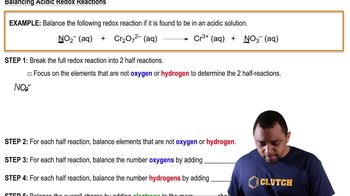The diagram that follows represents a molecular view of a process occurring at an electrode in a voltaic cell.
(c) Why are the atoms in the electrode represented by larger spheres than those in the solution? [Section 20.3]
 Verified step by step guidance
Verified step by step guidance


The diagram that follows represents a molecular view of a process occurring at an electrode in a voltaic cell.
(c) Why are the atoms in the electrode represented by larger spheres than those in the solution? [Section 20.3]
Assume that you want to construct a voltaic cell that uses the following half-reactions: A2+1aq2 + 2 e- ¡ A1s2 Ered ° = -0.10 V B2+1aq2 + 2 e- ¡ B1s2 E°red = -1.10 V You begin with the incomplete cell pictured here in which the electrodes are immersed in water.
(a) What additions must you make to the cell for it to generate a standard emf?
Consider the following table of standard electrode potentials for a series of hypothetical reactions in an aqueous solution: reduction half-reaction E °(V) (c) Which substance(s) can oxidize C2+?
Consider the following voltaic cell:
(c) What is the change in the cell voltage when the ion concentrations in the cathode half-cell are increased by a factor of 10?